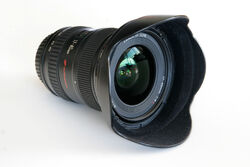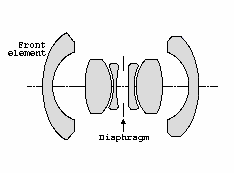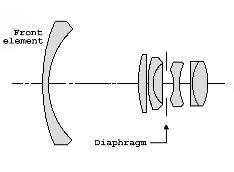No edit summary |
(→External links: fixed dead link) Tags: Visual edit apiedit |
||
| (One intermediate revision by one other user not shown) | |||
| Line 36: | Line 36: | ||
| + | |||
| − | [http://pixelstockphotos.com/ Stock Images UK] |
||
| + | |||
==Notes== |
==Notes== |
||
| Line 52: | Line 53: | ||
==External links== |
==External links== |
||
*[http://www.kevinwilley.com/l3_topic03.htm Wide Angle Lenses - Large Picture Angles] |
*[http://www.kevinwilley.com/l3_topic03.htm Wide Angle Lenses - Large Picture Angles] |
||
| − | *[http://www. |
+ | *[http://www.glamoureffekt.de/blog/compressing-distance-and-altering-perspective-hochzeitsfotograf Wide Angle Lens showing altered perspectives] |
[[Category:Photographic lenses]] |
[[Category:Photographic lenses]] |
||
Latest revision as of 19:22, 10 May 2015

One of Canon's most popular wide angle lenses - 17-40 mm f/4 L retrofocus zoom lens.
In photography and cinematography, a wide-angle lens is a lens whose focal length is substantially shorter than the focal length of a normal lens for the image size produced by the camera, whether this is dictated by the dimensions of the image aperture at the film plane for film cameras (film format)[1] or dimensions of the photosensor for digital cameras.
Generally, the normal lens for a particular format is approximately the diagonal distance from opposite corners of the image aperture or photosensor. (It is said to be "normal" because a lens of this focal length provides more or less the same perspective that humans see.) For example, for a full-frame 35 mm camera with a 36 mm by 24 mm format, the diagonal measures 43.3 mm and therefore, the lens that provides this angle of view, adopted by most manufacturers is the 50 mm lens. A lens of with a focal length of less than 50mm will be considered wide-angle, although this only becomes apparent at focal lengths of 35 mm or less.
Common wide-angle lenses for a full-frame 35 mm cameraare 35, 28, 24, 21, 18 and 14 mm. These lenses will produce a more or less rectilinear image at the film plane (though some degree of barrel distortion is not uncommon here).
Beyond a certain point, lenses can no longer produce rectilinear images due to their extremely wide fields of view. These lenses are often called fisheye lenses. Common focal lengths for these in the 35 mm format camera are 6 to 8 mm (which produce a circular image due to their field of view approaching 180 degrees). Lenses with focal lengths of 15 or 16 mm can produce either curvilinear fisheye-like (high barrel distortion) full-frame images or rectilinear full-frame images due to optical correction, depending on the design.
Wide angle lenses come in both single focus and zoom varieties. For 35 mm cameras, lenses producing rectilinear images can be found at focal lengths as short as 12 mm including zoom lenses with ranges of 2:1 that also begin at 12 mm.
In addition to giving a wider angle of view, the image produced by a wide-angle lens is more susceptible to perspective distortion than that produced by a normal lens.
The formula for calculating the angle of view for any lens that produces a rectilinear image can be found in the article angle of view.
Digital camera issues[]
Most interchangeable lens digital cameras today (2006) are in the form of 35 mm cameras. However, most of these cameras have photosensors that are smaller than the image apertures of full-frame 35 mm cameras.[2] For the most part, the dimensions of these photosensors are similar to the APS-C image aperture size, i.e., approximately 24 mm x 16 mm. Therefore, the angle of view for any given focal length lens will be narrower than it would be in a full-frame camera because the smaller sensor "sees" less of the image projected by the lens. The camera manufacturers provide a field of view factor to show the equivalent focal length if the camera had a full-frame sensor. The usual factor is 1.5,[3] indicating that the effective focal length of the lens on the camera is 1.5 times its actual focal length. As examples, a 28 mm lens would produce the angle of view of a 42 mm lens on a full-frame camera, and a 35 mm lens would produce a 52.5 mm angle view, which is not a wide angle view at all. So, to determine the focal length of a lens for a digital camera that will give the equivalent angle of view as one on a full-frame camera, the desired full-frame lens focal length must be divided by the field of view factor. For example, to get the equivalent angle of view of a 28 mm lens on a full frame 35 mm camera from a digital camera with a 1.5 field of view factor, one would use an 18 mm[4] lens.
Lens manufacturers have responded to this problem by making wide angle lenses of much shorter focal lengths for these cameras. In doing this, they limit the diameter of the image projected to slightly more than the diagonal measurement of the photosensor. This gives the designers more flexibility in providing the optical corrections necessary to economically produce high quality images at these short focal lengths, especially when the lenses are zoom lenses. Examples are 10 mm minimum focal length zoom lenses from several manufacturers. At 10 mm, these lenses provide the angle of view of a 15 mm lens on a full frame camera when the field of view factor is 1.5.
Construction[]

Cross-section - typical short focus wide angle lens.

Cross-section - typical retrofocus wide angle lens.
There are two different varieties of wide-angle lens: short-focus lenses and retrofocus lenses.
Short focus lenses are generally made up of multiple glass elements whose shapes are more or less symmetrical in front of and behind the diaphragm. As the focal length decreases, the distance of the rear element of the lens from the film plane or digital sensor also decreases. This makes short focus wide-angle lenses undesirable for single-lens reflex cameras unless they are used with the reflex mirrors locked up. Short focus lenses are widely used on large format view cameras.
The retrofocus lens solves this proximity problem through an asymmetrical design that allows the rear element to be further away from the film plane than its effective focal length would suggest. (See Angenieux retrofocus.) For example, it is not uncommon for the rear element of a retrofocus lens of 18mm to be more than 25 mm from the film plane. This makes it possible to design really wide angle lenses for single-lens reflex cameras.
Notes[]
- ↑ The term "image aperture" means the dimensions of the opening at the film plane through which the film is exposed. It is used hereafter instead of the term "film format" because it eliminates the potential ambiguity of whether reference is being made to the film size, e.g. 120 film, or to the dimensions of the image produced by the camera. For example, cameras using size 120 film may have image apertures of 4.5 cm x 6 cm, 6 cm x 6 cm or 6 cm x 7 cm.
- ↑ The few exceptions include the Canon EOS-1Ds Mark II and EOS 5D, and the now discontinued Kodak DCS SLR/c and DCS SLR/n.
- ↑ Although some cameras have field of view factors of 1.6 and 1.7.
- ↑ Rounded to the nearest standard focal length from the calculated 18.67 mm.
See also[]
- angle of view for an example of an image taken by a wide-angle lens
- film format
- normal lens
- anamorphic lens
- scioptric ball
- stitching images
- panorama camera